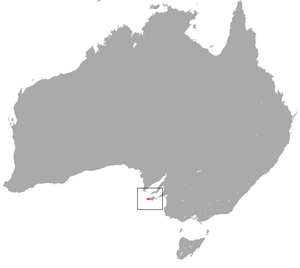Kangaroo Island dunnart facts for kids
Quick facts for kids Kangaroo Island dunnart |
|
|---|---|
| Conservation status | |
| Scientific classification | |
| Genus: |
Sminthopsis
|
| Species: |
aitkeni
|
 |
|
| Kangaroo Island Dunnart range | |
The Kangaroo Island dunnart (Sminthopsis aitkeni) is a small, mouse-like animal. It is a type of dunnart, which is a tiny marsupial. This dunnart has dark grey fur with lighter fur on its belly. Scientists first described it in 1969.
These dunnarts are quite small. They are about 17 to 20 centimeters (7-8 inches) long from head to tail. Their body is about 8 to 9 centimeters long, and their tail is even longer, measuring 9 to 10.5 centimeters. They weigh only about 20 to 25 grams, which is like a few quarters. Males are usually a bit bigger than females.
The Kangaroo Island dunnart is in great danger. It is listed as Critically Endangered by the International Union for Conservation of Nature (IUCN). Before the big bushfires in 2019–2020, there were thought to be fewer than 500 of these animals. After the fires, experts believe only about 50 are left.
Contents
Where Kangaroo Island Dunnarts Live
This special animal, a type of dasyurid, lives only on the western side of Kangaroo Island in South Australia. It is the only mammal that lives naturally only on this island.
Their Home Environment
Kangaroo Island dunnarts prefer to live in mallee heath areas. These are places with low, scrubby bushes and sandy soil. Scientists believe these dunnarts once lived all over Kangaroo Island.
Today, they have only been found in six specific spots. All these places are either in the Flinders Chase National Park or the Ravine des Casoars Wilderness Protection Area. Both of these protected areas are on the western part of the island. Sadly, recent searches for them on the eastern side of the island have not found any.
What Kangaroo Island Dunnarts Eat
The Kangaroo Island dunnart is a nocturnal animal. This means it is active at night.
Their Favorite Foods
Their diet mainly consists of invertebrates. These are small creatures without backbones, like insects and spiders. Studies of their droppings show that they mostly eat ants and spiders. They also enjoy scorpions, beetles, and grasshoppers.
Kangaroo Island Dunnart Life Cycle and Behavior
Not much is known about how Kangaroo Island dunnarts behave. However, scientists believe they can breed twice a year.
Reproduction and Young
Based on when young dunnarts are caught, it is thought they breed from mid-September to October. They may breed again in November to December. Their pregnancy lasts about 12 days.
Scientists do not know much about how the parents care for their young. It is believed that male dunnarts might only live long enough for one breeding season. Females, however, might live to breed for two seasons.
Protecting Kangaroo Island Dunnarts
The Kangaroo Island dunnart is listed as critically endangered. This means it faces an extremely high risk of disappearing forever. The Australian government created a plan to help them recover in 2011.
Threats to Their Survival
In the early 2000s, researchers were not sure if the dunnart population was truly so small. They wondered if the animals were just very good at hiding. Before the 2019–2020 bushfires, it was thought there were fewer than 500 individuals.
The dunnart's population has dropped for several reasons.
- Habitat Loss: A main reason is that their homes are disappearing. Although they do not have a clear favorite habitat, they need some low plants to survive. About half of Kangaroo Island's natural land has been cleared for farms and grazing animals. Dunnarts have not been found in these cleared areas.
- Plant Disease: A type of water mould called Phytophthora cinnamomi causes trees to die. This disease has also harmed dunnart populations.
- Feral Cats: Wild cats are also a problem. They hunt and kill native animals like the dunnart.
Impact of Bushfires
Kangaroo Island dunnart populations are very vulnerable because they live in such a small area. One big event can affect many of them. Forest fires are a major worry. The huge fires in 2019–2020 destroyed much of their remaining habitat.
In May 2019, before the fires, a meeting was held about the dunnart's situation. Government officials, scientists, and landowners attended. This meeting provided important information about the dunnart's status before the fires. The bushfires greatly harmed the population, likely wiping out most of the dunnarts. However, dunnarts have still been seen in both burned and unburned areas after the fires. This gives hope for their recovery.
See also
 In Spanish: Ratón marsupial de la Isla Canguro para niños
In Spanish: Ratón marsupial de la Isla Canguro para niños


